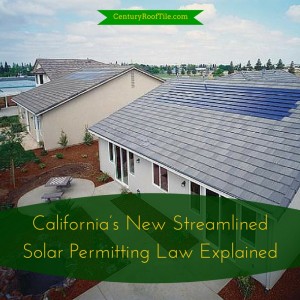California’s New Streamlined Solar Permitting Law Explained
Recent Solar Law Examined by an Expert Bay Area Solar Company

It has been four decades since California’s Solar Rights Act came into effect, firmly establishing the state’s policy of encouraging solar. Six sections of law[1] spelled out protections for solar energy installations while also establishing technical standards to be followed by the solar company.
But local administrative support and permitting requirements have remained remarkably uneven. In the midst of the recent colossal increase in solar installations, state officials have recognized that red tape and permitting costs still stood in the way for many homeowners looking to implement photovoltaic and other solar solutions. There was also a difficulty within homeowners’ associations, which sometimes thwarted solar installations by their members.
In response, California Assemblymember Al Muratsuchi introduced AB 2188, which passed into law in September (shortly before Muratsuchi was unseated in November elections). The law gives cities and counties one year, until September 30, 2015, to implement the following:
- Adopt an ordinance that creates an expedited, streamlined permitting process for small residential rooftop solar energy systems, meaning ≤10 kW AC or 30 kW thermal systems on a single or duplex family dwelling. The new permitting process must comply with recommendations and standard plans in the latest California Solar Permitting Guidebook.
- Adopt a checklist of all requirements for small rooftop solar energy systems to be eligible for expedited review. Again, this checklist must come from the Solar Permitting Guidebook.
- Publish the checklist and required permitting documentation for public access on the city/county website, if one exists. (The League of California Cities had opposed AB 2188 on the grounds that a website was a considerable expense; this language would ease that expense for towns too small to operate a website.)
Not only must the permit application and documentation be published online, but the applicant must be able to submit them online as well, and an electronic signature must be accepted. If the application is complete, the city or county must then approve the application and issue all required permits or authorizations. Then “only one inspection shall be required, which shall be done in a timely manner and may include a consolidated inspection.” An allowance is made for separate fire inspection if the local government does not have an agreement with its fire department to do this. (If the application is incomplete, the city/county must notify the applicant what is needed to properly complete it.)
Some homeowners wishing to install solar roofing or solar heating systems have run afoul of the covenants, conditions, and restrictions (CC&Rs) of homeowners’ associations. However, according to the new law, local governments are not allowed to condition permitting approval on approval of an association, defined in Civil Code § 4080. Civil Code 714 still allows homeowners’ associations to put reasonable restrictions on solar energy systems provided the restrictions do not significantly increase system costs or decrease efficiency; however, the word “significantly” has been redefined. It formerly meant a 20 percent increase in cost or decrease in efficiency; it now means a 10 percent increase in cost or decrease in efficiency.
Solar Roofing Installations are One of Our Specialties!
The team here at Century Roof and Solar can introduce you to technology that helps homeowners save money and the planet by using energy from the sun. Contact us today at (888) 233-7548 and let us help you with your solar energy roofing.
[1] California Civil Code §714 and 714.1, 801, 801.5; California Government Code §65850.5, 66475.3, and 66473.1; and California Health and Safety Code §17959.1.
